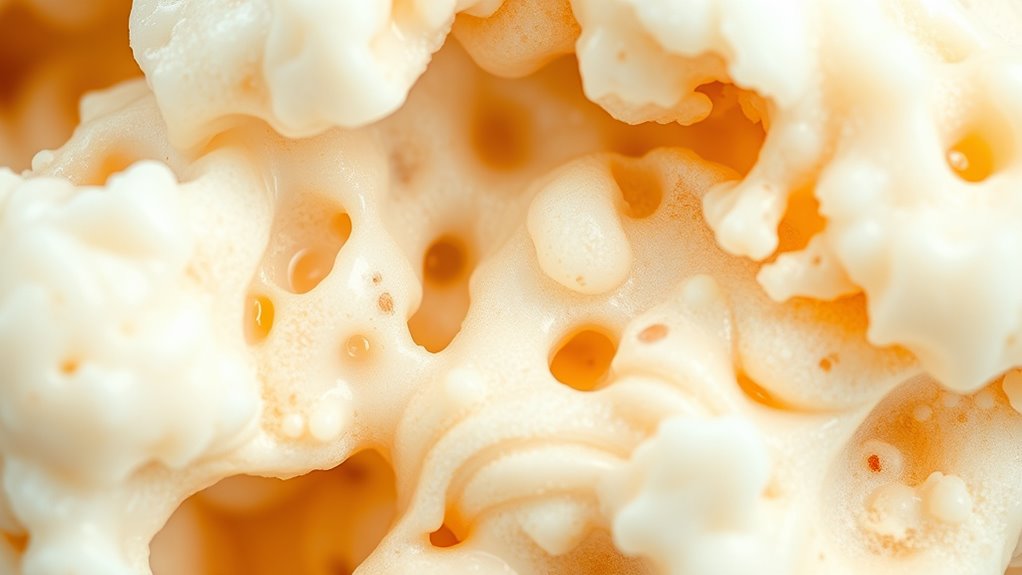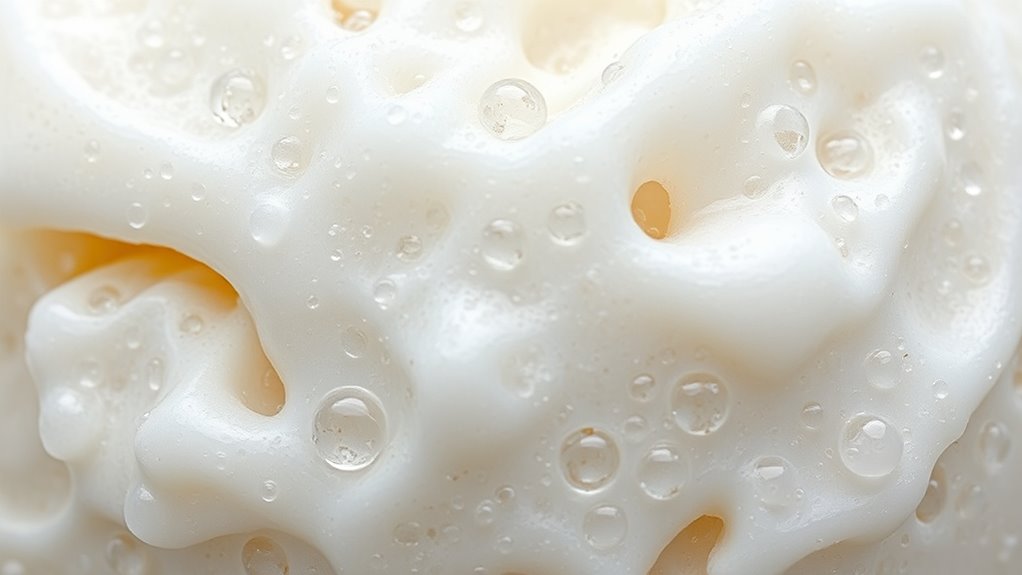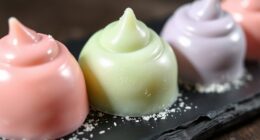Ice cream microstructure involves a delicate balance of foam, emulsion, and suspension that impacts its texture and stability. Tiny ice crystals form a network that feels smooth and creamy, while well-dispersed fat globules create richness. Air cells provide volume, and stable emulsions prevent separation. Rapid freezing techniques like cryogenic cooling help preserve this microstructure, ensuring a consistently silky experience. Keep exploring to discover how these components work together for perfect ice cream.
Key Takeaways
- Ice cream microstructure consists of ice crystals, fat globules, air cells, and stabilizers forming a complex foam, emulsion, and suspension system.
- Rapid freezing via cryogenic methods produces smaller ice crystals, maintaining uniform dispersion of fat globules and air, enhancing texture.
- Emulsifiers stabilize fat globules, preventing coalescence and ensuring smooth, creamy mouthfeel in the microstructure.
- The interplay between ice crystals, fat, and air affects ice cream’s firmness, creaminess, and resistance to syneresis.
- Controlling microstructure components during freezing is essential for achieving high-quality, indulgent ice cream textures.

Ice cream microstructure plays an essential role in determining its texture, creaminess, and overall quality. When you take a spoonful, you’re experiencing the complex interplay of tiny ice crystals, fat globules, air bubbles, and emulsifiers that form its microstructure. One of the key processes influencing this structure is cryogenic freezing. Unlike standard freezing methods, cryogenic freezing rapidly cools the ice cream mixture using supercooled gases like liquid nitrogen. This rapid cooling minimizes the size of ice crystals, resulting in a smoother, creamier texture because smaller crystals melt more quickly and feel silkier on your palate. It also helps prevent the formation of large ice crystals that can cause a grainy or icy mouthfeel, which is a common issue in slower freezing techniques. cryogenic freezing not only enhances texture but also reduces the formation of ice crystals that can compromise quality.
As the mixture freezes, fat globules—tiny droplets of fat suspended within the liquid—behave in ways that markedly impact the final product. During cryogenic freezing, the swift temperature drop causes fat globules to remain more uniformly distributed, avoiding coalescence or separation that can lead to a greasy or greasy sensation. Their behavior is essential because well-dispersed fat globules contribute to creaminess and smoothness. When fat globules stay evenly spread, they create a stable emulsion that enhances mouthfeel and flavor release. Conversely, if fat globules clump together or break down, the ice cream might feel greasy or less cohesive, diminishing its quality.
The microstructure also involves the interactions of these fat globules with other components. For example, emulsifiers like lecithin help stabilize the fat droplets, preventing them from merging and forming larger fat masses. Cryogenic freezing supports this stability by rapidly solidifying the mixture before fat globules can coalesce. This rapid solidification locks in the microstructure, preserving the delicate balance between ice crystals, fat globules, and air cells.
Understanding fat globule behavior during freezing is essential if you want a consistently high-quality ice cream. The faster cooling in cryogenic methods ensures fat globules retain their dispersed state, which translates into a richer, more uniform texture. It also minimizes the formation of ice crystals and reduces the risk of syneresis, where liquid separates out over time. So, the microstructure you experience—whether it’s smooth, creamy, or icy—largely depends on how effectively the fat globules are managed during the freezing process, especially when employing techniques like cryogenic freezing. This careful control results in ice cream that’s irresistibly smooth and indulgent with every spoonful.
Frequently Asked Questions
How Does Freezing Rate Affect Ice Cream Microstructure?
You should know that freezing rate considerably influences ice cream’s microstructure by affecting crystallization control. Rapid freezing creates smaller ice crystals, leading to a smoother texture, while slow freezing results in larger crystals, making it grainy. By adjusting freezing rates, you can optimize microstructure engineering, ensuring your ice cream has a desirable consistency and mouthfeel. This approach helps you produce higher quality ice cream with controlled crystal growth and improved overall texture.
What Role Do Stabilizers Play in Ice Cream Texture?
Stabilizers play a vital role in ice cream texture by preventing ice crystal growth and improving creaminess. Different stabilizer types, like guar gum, locust bean gum, or carrageenan, enhance texture by thickening the mixture and creating a smooth, stable structure. They help distribute air evenly, boost viscosity, and maintain desirable mouthfeel, making your ice cream creamier, less icy, and more enjoyable with each scoop.
Can Microstructure Influence Ice Cream Flavor Release?
Yes, microstructure influences flavor release in ice cream. By designing the microstructure, you can control flavor encapsulation, which affects how flavors are released when you eat it. A well-designed microstructure guarantees flavors are released gradually, enhancing taste. It also prevents rapid flavor loss, maintaining freshness. So, optimizing microstructure design allows you to tailor flavor release, creating a more enjoyable and flavorful ice cream experience.
How Do Temperature Fluctuations Impact Microstructural Stability?
Temperature fluctuations can critically impact microstructural stability by causing thermal expansion and contraction. You’ll notice that these changes can weaken the foam, emulsion, or suspension, reducing their resilience. This may lead to ice crystal growth or phase separation, affecting texture and quality. To maintain ideal microstructural resilience, controlling temperature variations during storage is essential, ensuring the ice cream stays smooth, creamy, and enjoyable.
What Are Emerging Techniques to Analyze Ice Cream Microstructure?
You might think traditional methods are enough, but emerging techniques like cryo-electron microscopy and confocal laser microscopy reveal detailed ice cream microstructures at the nanoscale. Cryo-EM captures frozen samples in their native state, while confocal laser microscopy offers 3D visualization of emulsions and foams. These advanced tools challenge old assumptions, providing precise insights that can improve texture, stability, and overall quality in ice cream formulations.
Conclusion
Understanding ice cream microstructure is like crafting a delicate tapestry—each foam, emulsion, and suspension weaves together to create that perfect scoop. Imagine biting into a scoop that’s as smooth as silk yet packed with tiny air bubbles, giving it creaminess and lightness. Just as a chef balances flavors, mastering microstructure guarantees your ice cream isn’t just tasty but irresistibly delightful. With this knowledge, you hold the secret to creating desserts that truly melt in your mouth.










